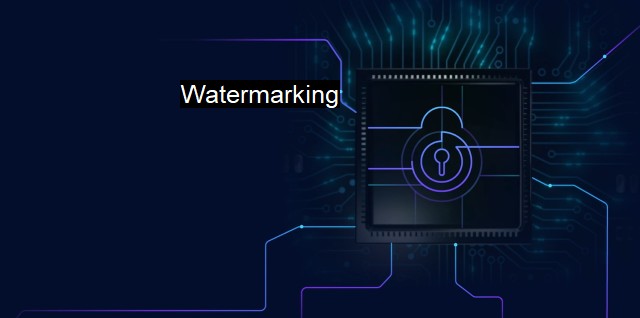What is Watermarking?
Watermarking: Safeguarding Digital Assets from Unwanted Sharing and Cyber Theft
Watermarking is a well-established tool used in various sectors, including digital media, telecommunications and information technology. in the realm of cybersecurity and antivirus protection, watermarking takes on even more importance as it becomes intricately tied to the protection of data and detecting unauthorized uses of certain digital properties.At its most basic level, watermarking is a method in which a characteristic, signature or stamp is placed onto a digital property to signal its source, authenticity or ownership. The watermark, can be a text, logo, or any other proprietary information. This is not dissimilar to old paper watermarks used on currencies or official documents, though now it operates in a digital framework. The watermark allows potential observers or sensors to know who the source of the data is, which can be incredibly useful in tracing origin or authenticating legitimate authority.
Watermarking becomes particularly important in the areas of cybersecurity and antivirus protection, due to its ability to quasi-mark data packets as legitimate. It serves two roles within these perspectives, both as a source of data authentication, and a prospective audits and control tool. By watermarking digital properties, a company or individual can assure that their digital documents, software or messages have a lower chance of being falsified, tampered with or illegally replicated. That aids significantly in maintaining the integrity of data, an issue that remains paramount in cybersecurity.
The watermark can play an active role in virus protection. Malware often entails unauthorized access to a system, using potential loophices to mask their activities. Here, watermarking can be utilized to make illicit entry or tampering more challenging, while also potentially offering a method for tracing any malicious activities. Antivirus software reciprocates this by monitoring for these digital watermarks, identifying and investigating any that seem out of place. The pertinency of such cannot be overstated, considering festivals of hackers, data thieves and malware are ever lurking in order to exploit value from compromised systems or data.
It should be noted that watermarking is just a tool or method within a wider security and safety strategy, and not a failsafe approach in itself. Sophisticated cybercriminals can sometimes avoid or distort watermarks, signaling truly legitimate data as suspicious. Meanwhile, its mere existence might sometimes make malicious observers more set on figuring out how to get through it, which potentially increases risks of security breaches.
What is also substantially noteworthy is that watermarking has given rise to so-called steganographic techniques. Quite complex to pin down, these involve embedding the watermark into the data itself, instead of overtly leaving it like a stamp. Done in such a way that it's not easily noticeable, it therefore becomes an enhanced measure to protect digital properties from malicious intent.
It remains essential to continually reassess and update watermarking techniques as critics can learn to decode or circumvent existing ones, thus underscoring a latent feature of cybersecurity – that continual innovation is required in response to the evolving landscape of digital matters.
Watermarking hence represents a highly coordinated approach to preserving and enhancing security on digital platforms. It’s poised to become even more critical considering transformations spurred by the rapid advancements in digital technology, against the backdrop of an increasingly globalized world that thrives on the generation and exchange of digital information. In cybersecurity and antivirus protection, watermarking will likely continue to hold significant sway as an important technique in the arsenal of measures protecting digital assets from unwanted cyber threats.

Watermarking FAQs
What is watermarking and how does it relate to cybersecurity?
Watermarking is the process of adding a unique identifier to a digital image or document to protect it from unauthorized use. In cybersecurity, watermarking is often used to prevent intellectual property theft and ensure the authenticity of digital content.How does watermarking differ from encryption?
Watermarking adds a visible or invisible mark to a digital file, whereas encryption scrambles the content of a file to protect it from unauthorized access. Watermarking is often used for copyright protection and verification, while encryption is used for data privacy and confidentiality.Can a watermark be removed or altered?
In some cases, it is possible to remove or alter a watermark, especially if it is a visible watermark. However, this process can be time-consuming and may result in a loss of image quality. Additionally, tampering with a watermark can be illegal and lead to legal consequences.What are some best practices for watermarking in antivirus and cybersecurity?
When implementing watermarking in antivirus and cybersecurity, it is important to use a unique and unalterable identifier, such as a digital signature or a hash code. It is also important to choose a watermark that does not affect the usability or functionality of the file. Regular updates and reviews of watermarking policies can help ensure continued effectiveness and adaptability to changing threats.| | A | | | B | | | C | | | D | | | E | | | F | | | G | | | H | | | I | | | J | | | K | | | L | | | M | |
| | N | | | O | | | P | | | Q | | | R | | | S | | | T | | | U | | | V | | | W | | | X | | | Y | | | Z | |
| | 1 | | | 2 | | | 3 | | | 4 | | | 7 | | | 8 | | |||||||